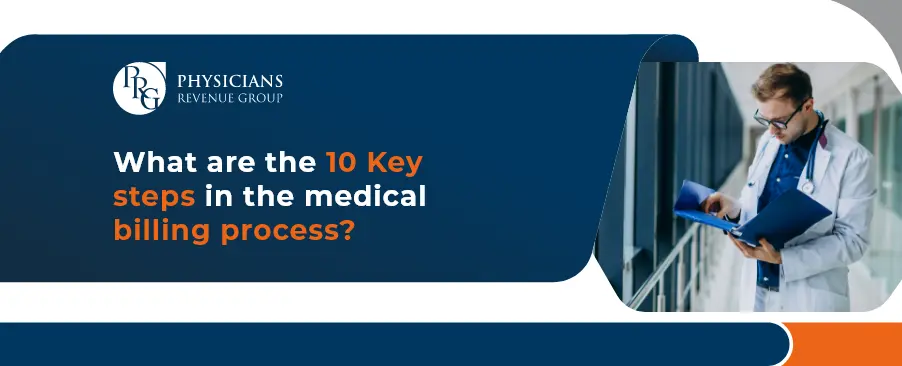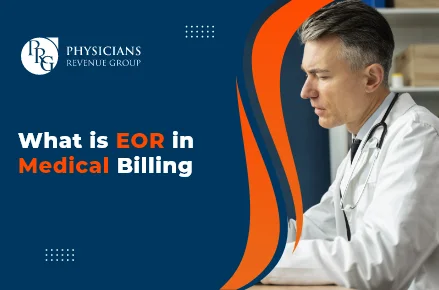
Email: info@prgmd.com | Call: +1 (630) 242-6474
Business hours: 9:00 to 5:00 | Monday to Friday
Email: info@prgmd.com | Call: +1 (630) 242-6474
Business hours: 9:00 to 5:00 | Monday to Friday

Table of Contents
ToggleWhile your primary focus should be on patient care – but as a healthcare practice owner, you must also take care of the financial side of your business. Consequently, you and your staff must follow the 10 key steps in the medical billing process. The process inside medical billing services begins with a patient visiting your practice. A patient’s visit can be in-person or remotely (think telemedicine, for instance). The said process ends when your practice receives payment.
The medical billing process comes with multi-faceted communication between:
Maintaining proper communication becomes tricky, especially when starting a new private practice. However, if you take care of all medical billing essentials and keep an error-free billing process, you can:
But what are the 10 key steps in the medical billing process?
Any flow chart showing the medical billing process begins with patient registration. This step collects various details to ensure smoother healthcare financial management. The necessary information includes
Equally important is the collection of insurance-related data, encompassing details like:
Before starting treatment, the front desk personnel schedule an appointment with the doctor. This scheduling is done by involving the collection of vital data from the patient. It’s essential to note that the success of the entire medical billing process centers on the accurate and professional execution of patient registration.
Moving along the key steps in the medical billing process, we have insurance verification. This stage establishes who holds financial responsibility for the upcoming services – the patient or the insurer. Before any services are given, engaging in thorough verification with the insurance company is essential.
During the insurance verification process, key aspects are checked to determine the financial details:
Moreover, the patient is duly informed about their responsibility for any services their insurance might not cover. This transparency fosters a clear understanding and sets the stage for a smoother medical billing experience.
When the patient arrives for their appointment, the medical billing process begins. During check-in, patients complete a form for their records. For returning patients, a review or update of existing information may be required. At this stage, identification and co-payments are also collected, ensuring possession of a working insurance card.
Upon the patient’s departure, which marks the second step in the medical billing journey, the collected medical reports undergo coding. A skilled medical coder takes the information from the visit and translates it into diagnostic and procedure codes. Subsequently, these details are combined to generate a document known as a “superbill” or “encounter report.”
The superbill encompasses key information such as:
This document streamlines the upcoming key steps in the medical billing process, ensuring accuracy and efficiency.
The two pivotal steps in superbill creation revolve around patient check-in and check-out. It also involves gathering essential information and necessary payments while the next steps transform medical reports into a structured superbill, laying the foundation for a seamless medical billing process.
Entering charges and generating claims are key steps in the medical billing process. Before submitting a claim to the insurance company, recording the service charges accurately is essential. This involves tracking medical data for patients and ensuring that the correct amounts are assigned to each service.
Once the charges are correctly recorded, the medical biller creates a medical claim. Subsequently, the biller is responsible for carefully reviewing the generated claim. This review is essential to confirm compliance with both payer and HIPAA guidelines. It encompasses analysis of medical billing accuracy and following specified formats.
When claims are transmitted through EDI, they undergo a three-level analysis for approval by insurance. These levels, each with specific responsibilities, ensure the accuracy and compliance of the submitted claims.
Scrubbing
Clearing House
The third-party contractor overseeing EDI conducts checks on patient records.
Insurance Rejection
Any errors or mistakes discovered at either of these levels result in claims being returned with a rejection message. This three-tiered audit process ensures the approval and subsequent adjudication of claims, enhancing the efficiency of the medical billing process.
Moving to one of the following key steps in the medical billing process, we focus on claims submission. This stage involves presenting the claim to the patient or their insurer. Usually done electronically for efficiency, only accurate, error-free claims are transmitted via Electronic Data Interchange to streamline reimbursement.
After submission, the adjudication process begins. Here, insurers assess claims for legitimacy and legality, determining the provider’s payment. Claims may be approved for reimbursement or denied based on compliance with the insurance agreement. Accuracy in claims is vital to ensure approval and reimbursement, highlighting the need for accuracy in medical billing.
In essence, claims submission is a bridge, connecting the careful examination to adjudication. This step determines reimbursement success, emphasizing the need for accuracy throughout the medical billing journey.
Denial management is integral to healthcare revenue cycle management, which aims to boost total revenue by minimizing insurance denials. This involves:
Each denied claim undergoes evaluation and research for adequate resolution, ensuring quicker payouts and strategic organization based on payer, amount, and other factors to optimize overall payouts. In essence, denial management is a comprehensive strategy for efficient and revenue-optimized medical billing.
Among the key steps in medical billing is patient statement preparation, followed by claims processing. This phase includes billing the patient for outstanding fees and typically involves:
Patient statement preparation facilitates transparent communication of charges, prices, insurance coverage, and the patient’s financial responsibilities.
Next on the key steps in medical billing is AR calling, taking center stage. The caller dedicated to accounts receivable (AR) focuses on two primary objectives:
Firstly, through prompt follow-ups with insurance providers, the AR caller plays a role in facilitating timely payments. Some conduct these follow-ups monthly, while others opt for a weekly pace. The frequency is often determined by the age of AR days, ensuring a strategic approach to converting due amounts into revenue.
Equally important is the primary goal of the AR caller, which is guaranteeing reimbursement for the treatments by healthcare professionals. To achieve this, they must share accurate patient information and promptly correct any mistakes in the billing process.
Furthermore, AR callers send reminders to patients or their insurance providers to maintain effective communication regarding outstanding payments. This approach helps expedite the key steps in medical billing, ensuring a steady revenue stream.
AR has a key role in the medical billing process and focuses on the following:
This involves strategic follow-ups, accurate information sharing, and timely reminders to optimize the AR days and convert due amounts into revenue.
Share:
Categories
Recently Added

What is an ABN in medical billing?

What does a Clearinghouse do During Claims Submission?

What is EOR in Medical Billing?
We Would Love to Assist You!
We treat your data confidentially and don’t share any information with a third party.